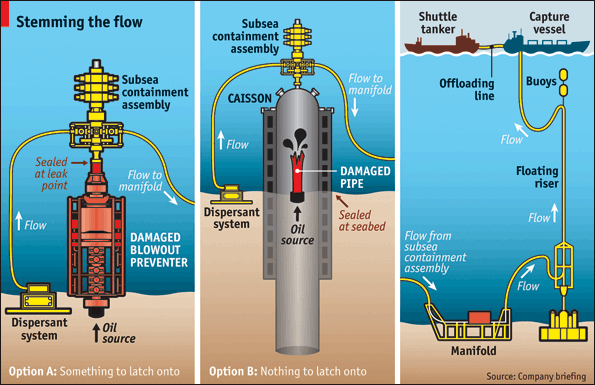The Economist has a great article on the The Price of Staying in the Game for oil companies and their collective $1 billion effort to figure out what to do should a deepwater spill happen again.
The companies involved outlined their plan in a August 4th public meeting held by the Bureau of Ocean Energy Management. They outlined three proposals to eliminate the devastating impact of an oil spill.

Option A: Something to latch onto.
Similar to the Collar, Cap, and Collector technique used to successfully seal the Macondo well, the main component would be a containment assembly that could fit on top of a damaged blowout preventer. In the absence of a preventer, the assembly could fit on top of various other wellhead equipment or even a bare pipe through a set of adaptors and vice-like grips. This assembly would have powerful rams that could seal off the flow and could have outlets to divert that flow, if need be, into undersea piping. The outlets prevent pressure building up in a badly damaged from springing new leaks somewhere else. There were worries for some time that something like this would happen at Macondo.
Option B: Nothing to latch onto, Suction Caissons.
Sometimes there is nothing to latch on to or the oil is gushing from a hole in the seabed. For situations like this the relief response system will have a range of watertight structures called caissons. These are based on suction-pile technology use to emplace deep-sea moorings and foundations.
[MORE RESEARCH ON CAISSONS AND SUCTION-PILE TECHNOLOGY TO FOLLOW]
The suction pile is open at one end. That end is put into the sediment where the pile is to be stuck. The air is then pumped out and water pressure pushes the pile into the seabed. To make an oil-collecting caisson, such a pile would be used as a collar around a funnel-topped tube that would sit over the leak. Various sizes of caisson will be built including one 50 feet in diameter (large enough to go over the whole blowout preventer).
Once the caisson was in position with the pile pumped out and in the seabed, the caisson would fill with oil from the leak. A containment assemble attached to the top of the caisson would divert oil to a manifold (a sort of switching yard for pipe) attached to one or more floating risers to the surface. The caisson could not simply be capped because the oil pressure would blow its suction pile out of the seabed.
Option C: Capture Vessels.
The floating risers would be held vertical by buoys and direct oil from the manifold to capture vessels kitted out with special modules to flare and pump gas to adjacent tankers. The whole system could cope with a flow of 200,000 barrels a day — more than three times the 63,000 barrels a day the government estimates was the Macondo well’s peak flow rate. The capture vessels could take other jobs around the gulf, but on contracts that allowed them to break off immediately in case of emergency.
These three procedures could have capped the Macondo well within weeks. The Economist concludes with the questions: “why did such a technologically astute industry not see fit to develop such useful equipment before it was needed, rather than after? And how might that underlying and disastrous lack of foresight be corrected?”
—
Interestingly, the article notes that, “Throughout the system there would be ways of warming things up and injecting antifreeze to prevent the formation of icelike methane hydrates.” I still believe the hydrates could be used as an effective solution to stopping future deepwater spills. Use of ice/hydrate forms in a caisson/suction pile could provide the expansion properties needed to block the flow and kill the spill.
